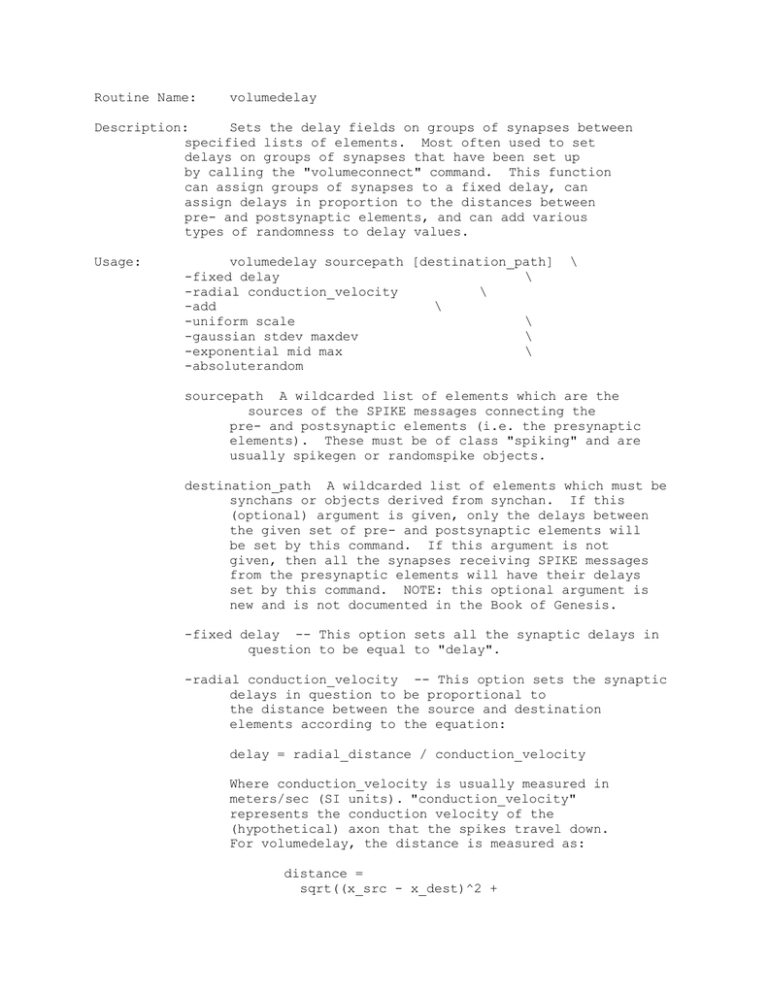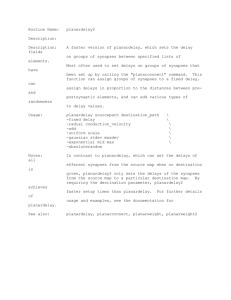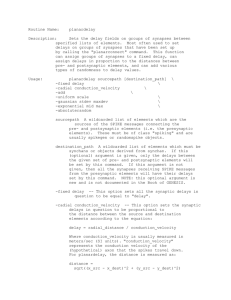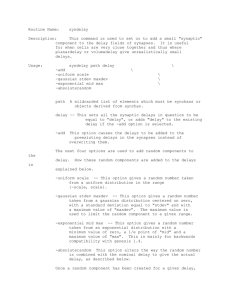VOLUMEDELAY.DOC
advertisement

Routine Name:
volumedelay
Description:
Sets the delay fields on groups of synapses between
specified lists of elements. Most often used to set
delays on groups of synapses that have been set up
by calling the "volumeconnect" command. This function
can assign groups of synapses to a fixed delay, can
assign delays in proportion to the distances between
pre- and postsynaptic elements, and can add various
types of randomness to delay values.
Usage:
volumedelay sourcepath [destination_path]
-fixed delay
\
-radial conduction_velocity
\
-add
\
-uniform scale
\
-gaussian stdev maxdev
\
-exponential mid max
\
-absoluterandom
\
sourcepath A wildcarded list of elements which are the
sources of the SPIKE messages connecting the
pre- and postsynaptic elements (i.e. the presynaptic
elements). These must be of class "spiking" and are
usually spikegen or randomspike objects.
destination_path A wildcarded list of elements which must be
synchans or objects derived from synchan. If this
(optional) argument is given, only the delays between
the given set of pre- and postsynaptic elements will
be set by this command. If this argument is not
given, then all the synapses receiving SPIKE messages
from the presynaptic elements will have their delays
set by this command. NOTE: this optional argument is
new and is not documented in the Book of Genesis.
-fixed delay -- This option sets all the synaptic delays in
question to be equal to "delay".
-radial conduction_velocity -- This option sets the synaptic
delays in question to be proportional to
the distance between the source and destination
elements according to the equation:
delay = radial_distance / conduction_velocity
Where conduction_velocity is usually measured in
meters/sec (SI units). "conduction_velocity"
represents the conduction velocity of the
(hypothetical) axon that the spikes travel down.
For volumedelay, the distance is measured as:
distance =
sqrt((x_src - x_dest)^2 +
(y_src - y_dest)^2 +
(z_src - z_dest)^2)
where x_src is the x component of the source
element,
x_dest is the x component of the destination
element,
and so on.
-add
This option causes the computed delays to be added to
the preexisting delays in the synapses instead of
overwriting them. This is useful when adding small
synaptic delays, among other uses.
The next four options are used to add random components to
the
delays established using the -fixed or -decay options. How
these random components are added to the delays is explained
below.
-uniform scale -- This option gives a random number taken
from a uniform distribution in the range
{-scale, scale}.
-gaussian stdev maxdev -- This option gives a random number
taken from a gaussian distribution centered on zero,
with a standard deviation equal to "stdev" and with
a maximum value of "maxdev". The maximum value is
used to limit the random component to a given range.
-exponential mid max -- This option gives a random number
taken from an exponential distribution with a
minimum value of zero, a 1/e point of "mid" and a
maximum value of "max". This is mainly for backwards
compatibility with genesis 1.4.
-absoluterandom This option alters the way the random number
is combined with the nominal delay to give the actual
delay, as described below.
Once a random component has been created for a given delay,
it is used to set the delay as follows. If the
-absoluterandom option has not been selected the delay is set
to be:
final_delay = delay + (delay * random_number)
Whereas if the -absoluterandom option has been selected then
we have
final_delay = delay + random_number
Thus the default is to have the amount of randomness as a
constant proportion of the delay value.
Example:
[modified from the Orient_tut simulation:]
volumedelay /retina/recplane/rec[]/input \
-radial {CABLE_VEL}
\
-gaussian 0.1 0.3
This command will set the size of the delays of synapses
that are receiving their inputs from
/retina/recplane/rec[]/input. It gives delays equal to the
radial distance between elements divided by the conduction
velocity (CABLE_VEL). It also specifies that gaussian noise
be added to the delays with a mean value of 0.1 (which
represents 10% of the original delay, since -absoluterandom
has not been selected) and a maximum value of 0.3 (which is
30% of the original delay value).
Notes:
not
The "destination_path" optional argument is new and is
documented in the Book of GENESIS.
This routine calculates distance using the x, y, and z
coordinates of the element positions and is thus more
realistic than planardelay, which only uses the x and y
directions. In general, we encourage users to use this
function instead of planardelay, which is mainly provided
for backwards compatibility with genesis 1.4.
The delays are never allowed to go negative even if a large
negative random component is added. Negative delays are set
to zero.
If the -add option is chosen, the random component modifies
only the delay added and not the total delay.
See also:
18
planardelay, volumeconnect, volumeweight, syndelay; Chapter
of the Book of GENESIS (2nd ed.) has a lengthy discussion
on
this and related commands.




